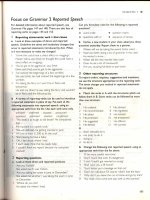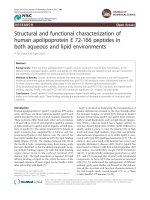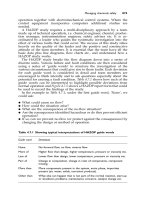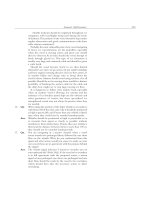Astm e 1079 16
Bạn đang xem bản rút gọn của tài liệu. Xem và tải ngay bản đầy đủ của tài liệu tại đây (68.51 KB, 2 trang )
Designation: E1079 − 16
Standard Practice for
Calibration of Transmission Densitometers1
This standard is issued under the fixed designation E1079; the number immediately following the designation indicates the year of
original adoption or, in the case of revision, the year of last revision. A number in parentheses indicates the year of last reapproval. A
superscript epsilon (´) indicates an editorial change since the last revision or reapproval.
1. Scope
dance with this practice provides the assurance that accurate
density values of radiographs are obtained.
2
1.1 This practice covers the calibration of transmission
densitometers used to perform radiographic film density measurements (see Note 1).
1.2 This standard does not purport to address all of the
safety concerns, if any, associated with its use. It is the
responsibility of the user of this standard to establish appropriate safety and health practices and determine the applicability of regulatory limitations prior to use.
5. Apparatus
5.1 Apparatus should consist of the following:
5.1.1 A calibrated step tablet covering the density range
used in production radiographs shall be used. The step tablet
may be a NIST X-ray Step Tablet (X-Ray Film Step Tablet
Transmission Density Standard 38100C)5, or alternately a step
tablet from another supplier that is traceable to the NIST step
tablet in the range provided by NIST certification. The step
tablet shall have at least five step densities, which cover the
density range that is used for production radiographs. A
calibration certificate shall be provided with the step tablet
indicating the tablet ID and recorded values for each step
density. For suppliers of step tablets other than NIST, the
certificate shall indicate conformance of traceability to NIST,
applicable ISO or ANSI standards (for example, ISO 5–3)
used, verification of measurement on a NIST step tablet, the ID
number of the step tablet, and calibration date of the step tablet.
Precautions should be taken in the storage, handling, and use of
the step tablet. In the event it becomes scratched, blemished, or
exhibits other signs of deleterious wear, it should be replaced
immediately. The NIST (or alternate, if used) step tablet shall
be replaced four years from the date of first use.6
5.1.2 Transmission Densitometers, with either direct-scale
readout or digital readout displays specifically manufactured
for the purpose of measuring the range of film densities
described in 5.1.1 may be used.
5.1.3 Manufacturer’s Operating Instructions for Appropriate Transmission Densitometer.
NOTE 1—For further information on the design and use of
densitometers, the following literature is suggested as additional background information: ISO 5–1:2009, ISO 5–2:2009, ISO 5–3:2009, and
ISO 14807:2001.
2. Referenced Documents
2.1 ASTM Standards:3
E1316 Terminology for Nondestructive Examinations
2.2 ISO Standards:4
ISO 5–3:2009 Photography and Graphic Technology - Density Measurements - Part 3: Spectral Conditions
ISO 14807:2001 Photography - Transmission and Reflection
Densitometers - Method for Determining Performance
3. Terminology
3.1 Definitions—For definitions of terms used in this
practice, see Terminology E1316.
4. Significance and Use
4.1 This practice provides a means for calibrating transmission densitometers used for the measurement of radiographic
film density. A transmission densitometer calibrated in accor-
6. Calibration
6.1 Full-scale linearity calibration should be performed at
least every 90 days during use as follows:
6.1.1 Use the manufacturer’s recommended warm-up time
to stabilize circuitry before starting the calibration procedure or
the periodic verification checks described in Section 7. Adjust
the “0” reading of the densitometer after the warm-up period.
1
This practice is under the jurisdiction of ASTM Committee E07 on Nondestructive Testing and is the direct responsibility of Subcommittee E07.01 on
Radiology (X and Gamma) Method.
Current edition approved June 1, 2016. Published June 2016. Originally
approved in 1985. Last previous edition approved in 2010 as E1079 - 10. DOI:
10.1520/E1079-16.
2
For ASME Boiler and Pressure Vessel Code applications see related Practice
SE-1079 in Section II of that Code.
3
For referenced ASTM standards, visit the ASTM website, www.astm.org, or
contact ASTM Customer Service at For Annual Book of ASTM
Standards volume information, refer to the standard’s Document Summary page on
the ASTM website.
4
Available from American National Standards Institute (ANSI), 25 W. 43rd St.,
4th Floor, New York, NY 10036.
5
Available from National Institute of Standards and Technology (NIST), 100
Bureau Dr., Stop 1070, Gaithersburg, MD 20899-1070, .
6
Expiration interval of the NIST or alternate step tablet may be different than the
requirements of this practice. Unless otherwise specified, requirements of this
practice shall apply.
Copyright © ASTM International, 100 Barr Harbor Drive, PO Box C700, West Conshohocken, PA 19428-2959. United States
1
E1079 − 16
density check shall be subject to a re-verification for density
after the densitometer has been recalibrated.
6.1.2 Select and measure three steps on the calibrated step
tablet densities below, above, and near the midpoint of the
range that is used for production radiographs.
6.1.3 Compare the measured densities with the actual density values on the calibrated step tablet or the density values
listed on the calibration certificate. Calibrate the densitometer,
in accordance with manufacturer recommendations, in order to
achieve measured densities which are as close as possible to
the actual density values on the step tablet. If the densitometer
has been calibrated properly, the measured densities at the
three steps should not vary more than 60.05 density units from
the actual step tablet density values. If any of the measured
density values vary more than 60.05 density units from the
density values on the step tablet, the linearity of the densitometer is out of tolerance and should be taken out of service until
corrected and recalibrated.
7.2 Consult the Manufacturer’s Technical Manual for
troubleshooting information.
8. Records and Associated Documentation
8.1 Note the densitometer calibration and periodic verification acceptance condition in an appropriate log. This log shall
also indicate the date the calibration/verification was performed and the identification of the individual who performed
the calibration/verification and shall be traceable to the applicable densitometer. The retention period for calibration/
verification documentation should be agreed upon by the
purchaser and supplier.
8.2 An alternative calibration/verification documentation
system may be used provided the calibration/verification traceability requirements identified in 8.1 can be satisfied and
documented properly. A pressure sensitive label or tag that
indicates the date the calibration/verification was performed,
and the identification of the individual performing the
calibration/verification, may be applied to the densitometer for
verification of the calibration reference check recorded in the
calibration/verification log.
6.2 Any densitometer that is dropped, repaired, or has had
critical parts replaced should be recalibrated prior to use.
7. Periodic Verification
7.1 Periodic calibration verification checks using the procedure described in Section 6 should be performed at the
beginning of each shift, after 8 h of continuous operation, or
change of apertures, whichever occurs first.
7.1.1 If the verification reading is within 60.05 of the
density values listed on the calibration step tablet or calibration
certificate, the densitometer is ready for continued use. If the
density values are not within the tolerance, recalibration is
required and it shall be performed in accordance with Section
6.
7.1.2 If the verification check shows a variation greater than
60.05, then all radiographs examined since the last acceptable
8.3 Note and record the date of first use of the calibration/
verification step tablet so that the requirements of 5.1.1 can be
satisfied.
9. Keywords
9.1 calibration; densitometer; density; periodic verification;
radiographic film
ASTM International takes no position respecting the validity of any patent rights asserted in connection with any item mentioned
in this standard. Users of this standard are expressly advised that determination of the validity of any such patent rights, and the risk
of infringement of such rights, are entirely their own responsibility.
This standard is subject to revision at any time by the responsible technical committee and must be reviewed every five years and
if not revised, either reapproved or withdrawn. Your comments are invited either for revision of this standard or for additional standards
and should be addressed to ASTM International Headquarters. Your comments will receive careful consideration at a meeting of the
responsible technical committee, which you may attend. If you feel that your comments have not received a fair hearing you should
make your views known to the ASTM Committee on Standards, at the address shown below.
This standard is copyrighted by ASTM International, 100 Barr Harbor Drive, PO Box C700, West Conshohocken, PA 19428-2959,
United States. Individual reprints (single or multiple copies) of this standard may be obtained by contacting ASTM at the above
address or at 610-832-9585 (phone), 610-832-9555 (fax), or (e-mail); or through the ASTM website
(www.astm.org). Permission rights to photocopy the standard may also be secured from the Copyright Clearance Center, 222
Rosewood Drive, Danvers, MA 01923, Tel: (978) 646-2600; />
2


![E:Tuan 16 CKTKN[2].doc](https://media.store123doc.com/images/document/2014_07/04/medium_nkp1382471123.jpg)






